Requirement Analysis and Modelling Report for SADBOMS System
VerifiedAdded on 2022/10/15
|9
|1144
|13
Report
AI Summary
This report provides a comprehensive analysis of the requirement analysis and modeling for the Stevenage Amateur Dramatic Box Office and Membership System (SADBOMS). It utilizes Unified Modeling Language (UML) diagrams to visually represent the system's structure and behavior. The report includes a sequence diagram illustrating the online reservation process, a class diagram depicting the booking subsystem's classes and their relationships, and a state machine diagram detailing the reservation process. These diagrams collectively offer a structured approach to understanding and implementing the SADBOMS system efficiently. The report is intended to assist the Stevenage Amateur Society (SADS) theatre in comprehending and effectively implementing the system.
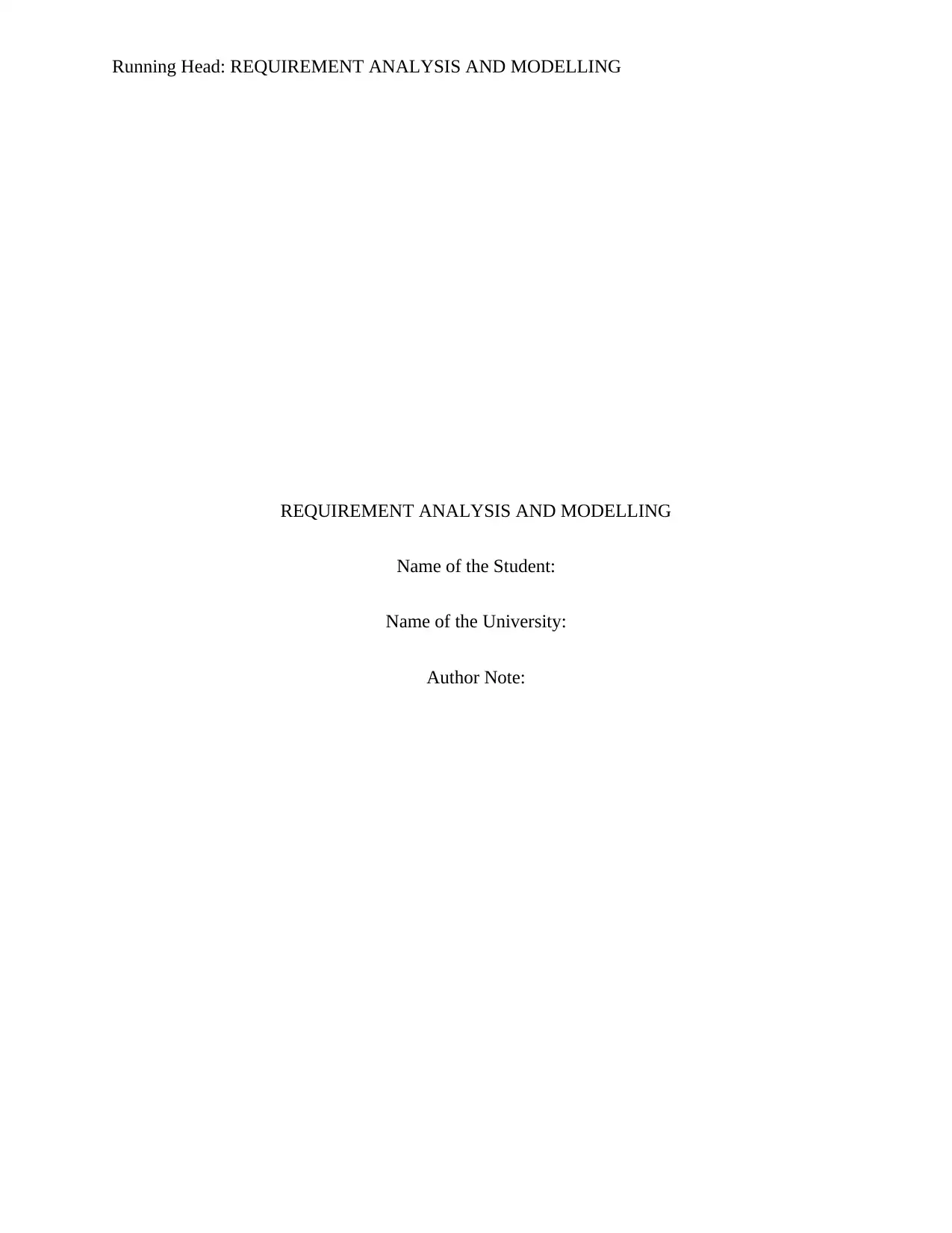
Running Head: REQUIREMENT ANALYSIS AND MODELLING
REQUIREMENT ANALYSIS AND MODELLING
Name of the Student:
Name of the University:
Author Note:
REQUIREMENT ANALYSIS AND MODELLING
Name of the Student:
Name of the University:
Author Note:
Paraphrase This Document
Need a fresh take? Get an instant paraphrase of this document with our AI Paraphraser
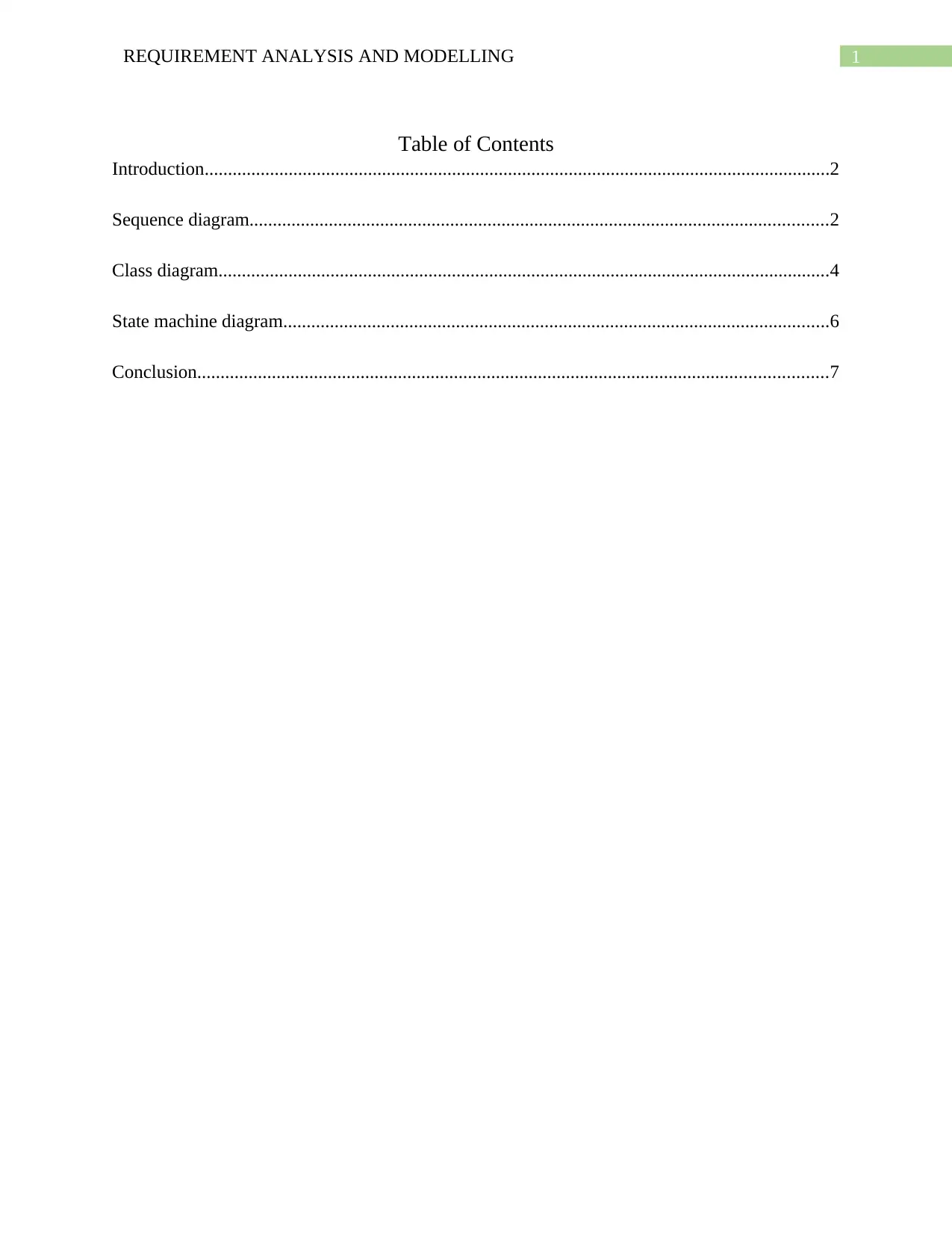
1REQUIREMENT ANALYSIS AND MODELLING
Table of Contents
Introduction......................................................................................................................................2
Sequence diagram............................................................................................................................2
Class diagram...................................................................................................................................4
State machine diagram.....................................................................................................................6
Conclusion.......................................................................................................................................7
Table of Contents
Introduction......................................................................................................................................2
Sequence diagram............................................................................................................................2
Class diagram...................................................................................................................................4
State machine diagram.....................................................................................................................6
Conclusion.......................................................................................................................................7
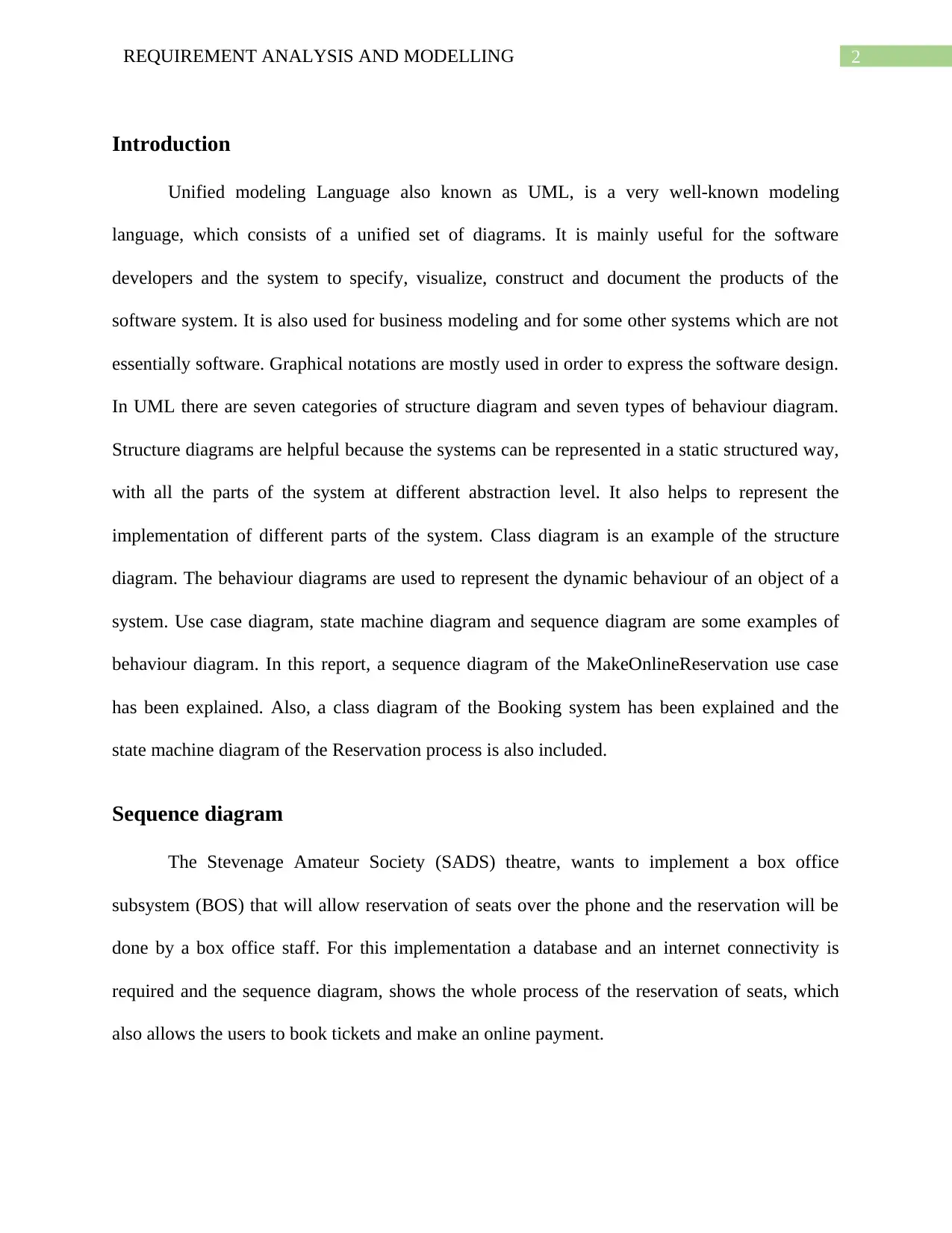
2REQUIREMENT ANALYSIS AND MODELLING
Introduction
Unified modeling Language also known as UML, is a very well-known modeling
language, which consists of a unified set of diagrams. It is mainly useful for the software
developers and the system to specify, visualize, construct and document the products of the
software system. It is also used for business modeling and for some other systems which are not
essentially software. Graphical notations are mostly used in order to express the software design.
In UML there are seven categories of structure diagram and seven types of behaviour diagram.
Structure diagrams are helpful because the systems can be represented in a static structured way,
with all the parts of the system at different abstraction level. It also helps to represent the
implementation of different parts of the system. Class diagram is an example of the structure
diagram. The behaviour diagrams are used to represent the dynamic behaviour of an object of a
system. Use case diagram, state machine diagram and sequence diagram are some examples of
behaviour diagram. In this report, a sequence diagram of the MakeOnlineReservation use case
has been explained. Also, a class diagram of the Booking system has been explained and the
state machine diagram of the Reservation process is also included.
Sequence diagram
The Stevenage Amateur Society (SADS) theatre, wants to implement a box office
subsystem (BOS) that will allow reservation of seats over the phone and the reservation will be
done by a box office staff. For this implementation a database and an internet connectivity is
required and the sequence diagram, shows the whole process of the reservation of seats, which
also allows the users to book tickets and make an online payment.
Introduction
Unified modeling Language also known as UML, is a very well-known modeling
language, which consists of a unified set of diagrams. It is mainly useful for the software
developers and the system to specify, visualize, construct and document the products of the
software system. It is also used for business modeling and for some other systems which are not
essentially software. Graphical notations are mostly used in order to express the software design.
In UML there are seven categories of structure diagram and seven types of behaviour diagram.
Structure diagrams are helpful because the systems can be represented in a static structured way,
with all the parts of the system at different abstraction level. It also helps to represent the
implementation of different parts of the system. Class diagram is an example of the structure
diagram. The behaviour diagrams are used to represent the dynamic behaviour of an object of a
system. Use case diagram, state machine diagram and sequence diagram are some examples of
behaviour diagram. In this report, a sequence diagram of the MakeOnlineReservation use case
has been explained. Also, a class diagram of the Booking system has been explained and the
state machine diagram of the Reservation process is also included.
Sequence diagram
The Stevenage Amateur Society (SADS) theatre, wants to implement a box office
subsystem (BOS) that will allow reservation of seats over the phone and the reservation will be
done by a box office staff. For this implementation a database and an internet connectivity is
required and the sequence diagram, shows the whole process of the reservation of seats, which
also allows the users to book tickets and make an online payment.
⊘ This is a preview!⊘
Do you want full access?
Subscribe today to unlock all pages.

Trusted by 1+ million students worldwide
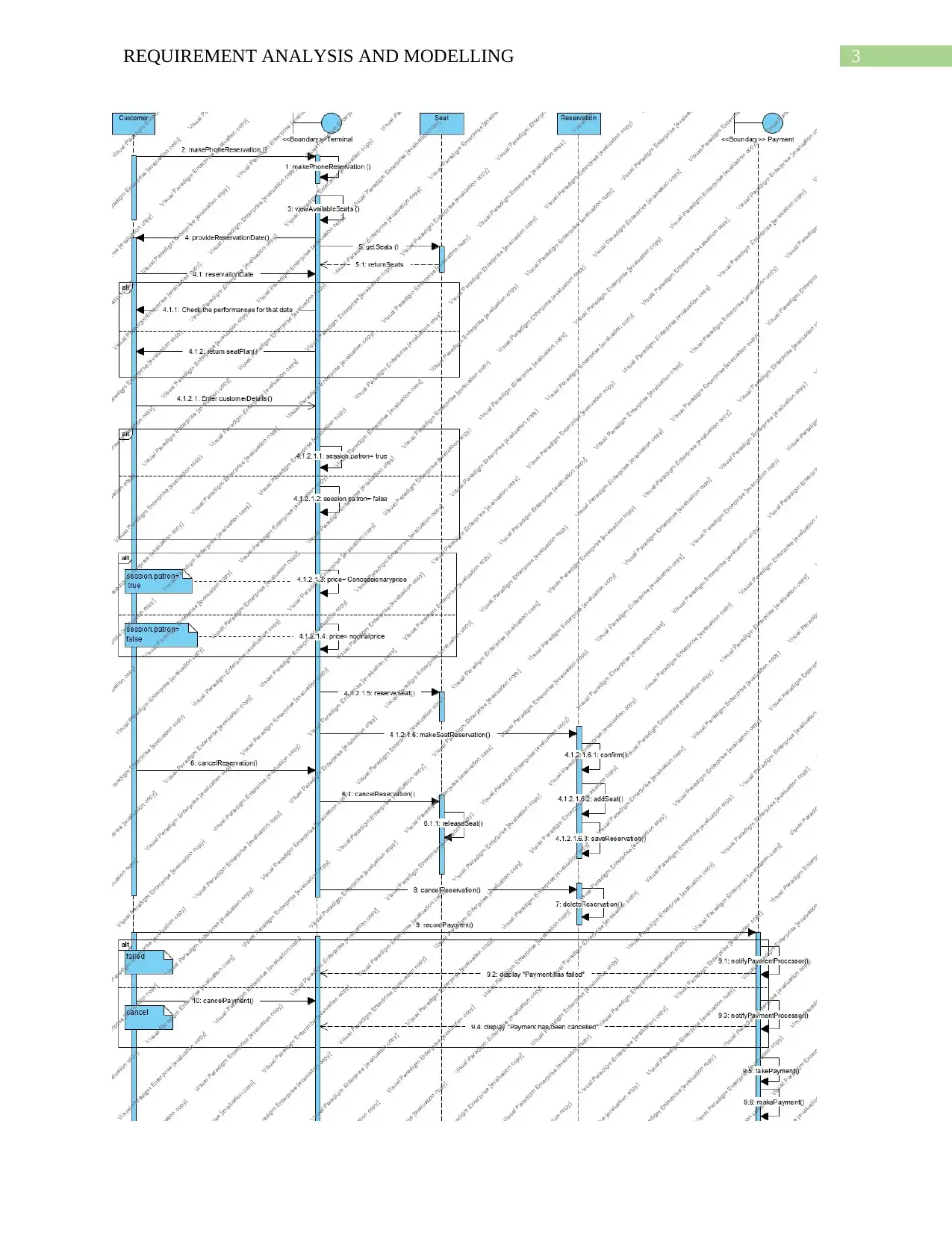
3REQUIREMENT ANALYSIS AND MODELLING
Paraphrase This Document
Need a fresh take? Get an instant paraphrase of this document with our AI Paraphraser
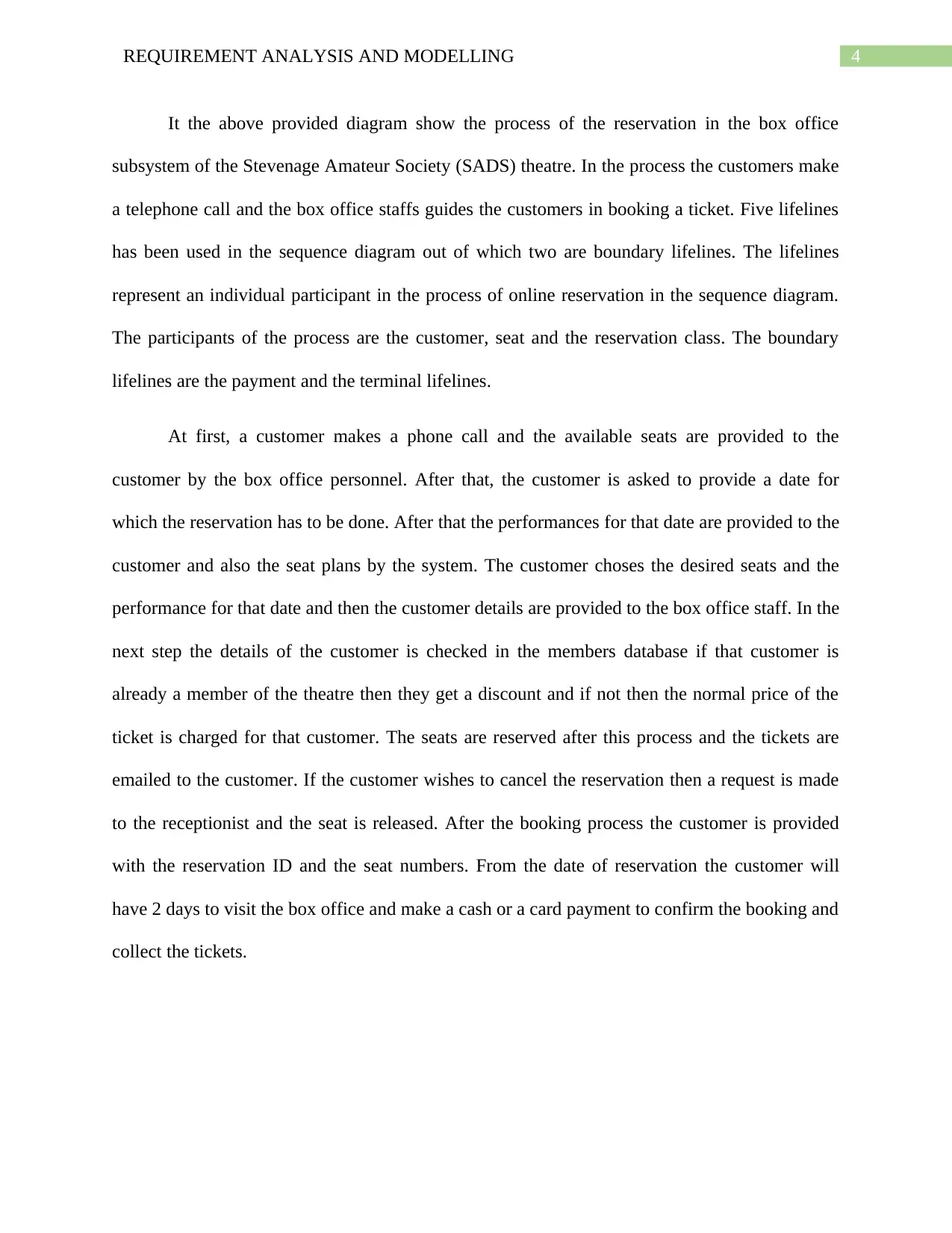
4REQUIREMENT ANALYSIS AND MODELLING
It the above provided diagram show the process of the reservation in the box office
subsystem of the Stevenage Amateur Society (SADS) theatre. In the process the customers make
a telephone call and the box office staffs guides the customers in booking a ticket. Five lifelines
has been used in the sequence diagram out of which two are boundary lifelines. The lifelines
represent an individual participant in the process of online reservation in the sequence diagram.
The participants of the process are the customer, seat and the reservation class. The boundary
lifelines are the payment and the terminal lifelines.
At first, a customer makes a phone call and the available seats are provided to the
customer by the box office personnel. After that, the customer is asked to provide a date for
which the reservation has to be done. After that the performances for that date are provided to the
customer and also the seat plans by the system. The customer choses the desired seats and the
performance for that date and then the customer details are provided to the box office staff. In the
next step the details of the customer is checked in the members database if that customer is
already a member of the theatre then they get a discount and if not then the normal price of the
ticket is charged for that customer. The seats are reserved after this process and the tickets are
emailed to the customer. If the customer wishes to cancel the reservation then a request is made
to the receptionist and the seat is released. After the booking process the customer is provided
with the reservation ID and the seat numbers. From the date of reservation the customer will
have 2 days to visit the box office and make a cash or a card payment to confirm the booking and
collect the tickets.
It the above provided diagram show the process of the reservation in the box office
subsystem of the Stevenage Amateur Society (SADS) theatre. In the process the customers make
a telephone call and the box office staffs guides the customers in booking a ticket. Five lifelines
has been used in the sequence diagram out of which two are boundary lifelines. The lifelines
represent an individual participant in the process of online reservation in the sequence diagram.
The participants of the process are the customer, seat and the reservation class. The boundary
lifelines are the payment and the terminal lifelines.
At first, a customer makes a phone call and the available seats are provided to the
customer by the box office personnel. After that, the customer is asked to provide a date for
which the reservation has to be done. After that the performances for that date are provided to the
customer and also the seat plans by the system. The customer choses the desired seats and the
performance for that date and then the customer details are provided to the box office staff. In the
next step the details of the customer is checked in the members database if that customer is
already a member of the theatre then they get a discount and if not then the normal price of the
ticket is charged for that customer. The seats are reserved after this process and the tickets are
emailed to the customer. If the customer wishes to cancel the reservation then a request is made
to the receptionist and the seat is released. After the booking process the customer is provided
with the reservation ID and the seat numbers. From the date of reservation the customer will
have 2 days to visit the box office and make a cash or a card payment to confirm the booking and
collect the tickets.
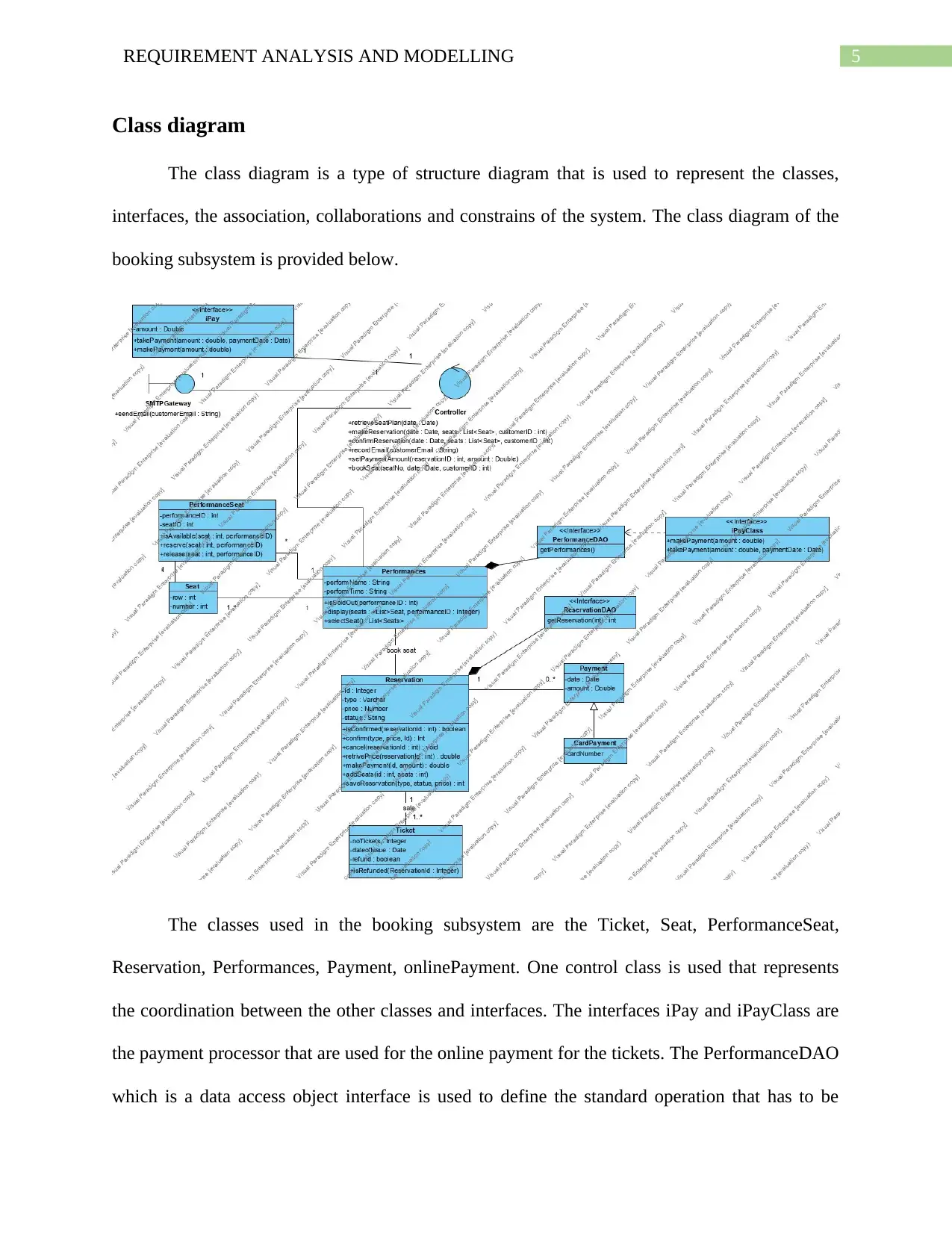
5REQUIREMENT ANALYSIS AND MODELLING
Class diagram
The class diagram is a type of structure diagram that is used to represent the classes,
interfaces, the association, collaborations and constrains of the system. The class diagram of the
booking subsystem is provided below.
The classes used in the booking subsystem are the Ticket, Seat, PerformanceSeat,
Reservation, Performances, Payment, onlinePayment. One control class is used that represents
the coordination between the other classes and interfaces. The interfaces iPay and iPayClass are
the payment processor that are used for the online payment for the tickets. The PerformanceDAO
which is a data access object interface is used to define the standard operation that has to be
Class diagram
The class diagram is a type of structure diagram that is used to represent the classes,
interfaces, the association, collaborations and constrains of the system. The class diagram of the
booking subsystem is provided below.
The classes used in the booking subsystem are the Ticket, Seat, PerformanceSeat,
Reservation, Performances, Payment, onlinePayment. One control class is used that represents
the coordination between the other classes and interfaces. The interfaces iPay and iPayClass are
the payment processor that are used for the online payment for the tickets. The PerformanceDAO
which is a data access object interface is used to define the standard operation that has to be
⊘ This is a preview!⊘
Do you want full access?
Subscribe today to unlock all pages.

Trusted by 1+ million students worldwide
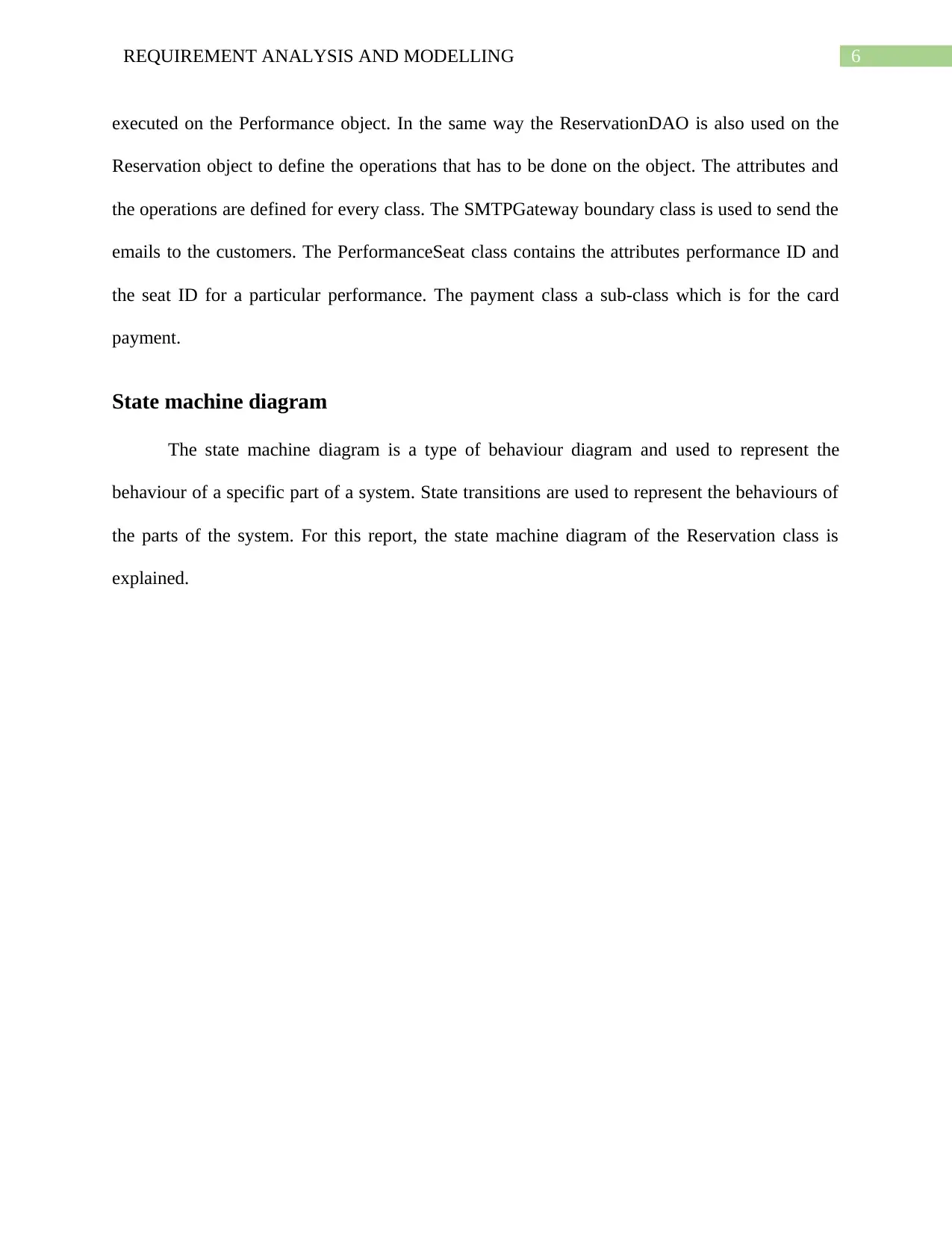
6REQUIREMENT ANALYSIS AND MODELLING
executed on the Performance object. In the same way the ReservationDAO is also used on the
Reservation object to define the operations that has to be done on the object. The attributes and
the operations are defined for every class. The SMTPGateway boundary class is used to send the
emails to the customers. The PerformanceSeat class contains the attributes performance ID and
the seat ID for a particular performance. The payment class a sub-class which is for the card
payment.
State machine diagram
The state machine diagram is a type of behaviour diagram and used to represent the
behaviour of a specific part of a system. State transitions are used to represent the behaviours of
the parts of the system. For this report, the state machine diagram of the Reservation class is
explained.
executed on the Performance object. In the same way the ReservationDAO is also used on the
Reservation object to define the operations that has to be done on the object. The attributes and
the operations are defined for every class. The SMTPGateway boundary class is used to send the
emails to the customers. The PerformanceSeat class contains the attributes performance ID and
the seat ID for a particular performance. The payment class a sub-class which is for the card
payment.
State machine diagram
The state machine diagram is a type of behaviour diagram and used to represent the
behaviour of a specific part of a system. State transitions are used to represent the behaviours of
the parts of the system. For this report, the state machine diagram of the Reservation class is
explained.
Paraphrase This Document
Need a fresh take? Get an instant paraphrase of this document with our AI Paraphraser
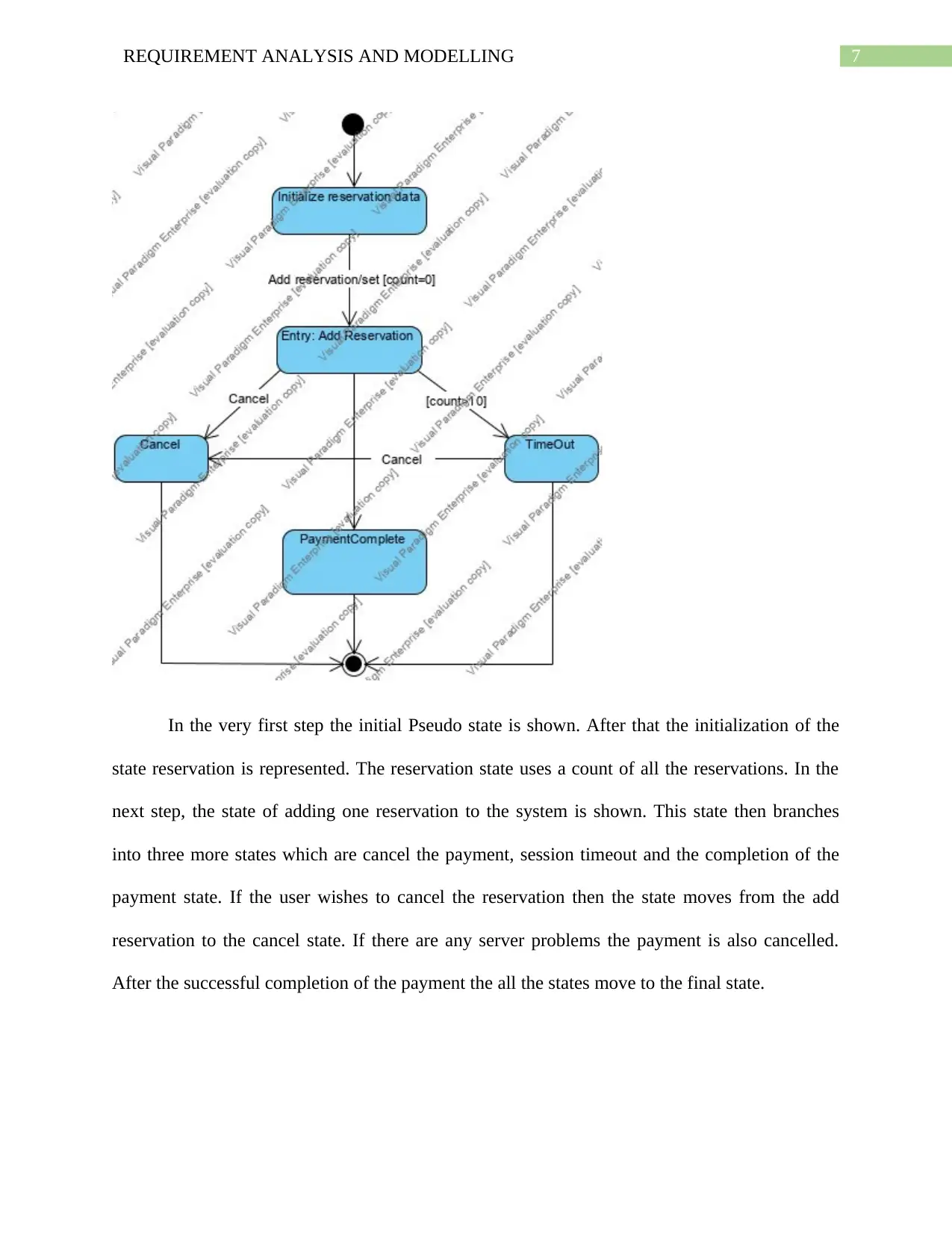
7REQUIREMENT ANALYSIS AND MODELLING
In the very first step the initial Pseudo state is shown. After that the initialization of the
state reservation is represented. The reservation state uses a count of all the reservations. In the
next step, the state of adding one reservation to the system is shown. This state then branches
into three more states which are cancel the payment, session timeout and the completion of the
payment state. If the user wishes to cancel the reservation then the state moves from the add
reservation to the cancel state. If there are any server problems the payment is also cancelled.
After the successful completion of the payment the all the states move to the final state.
In the very first step the initial Pseudo state is shown. After that the initialization of the
state reservation is represented. The reservation state uses a count of all the reservations. In the
next step, the state of adding one reservation to the system is shown. This state then branches
into three more states which are cancel the payment, session timeout and the completion of the
payment state. If the user wishes to cancel the reservation then the state moves from the add
reservation to the cancel state. If there are any server problems the payment is also cancelled.
After the successful completion of the payment the all the states move to the final state.
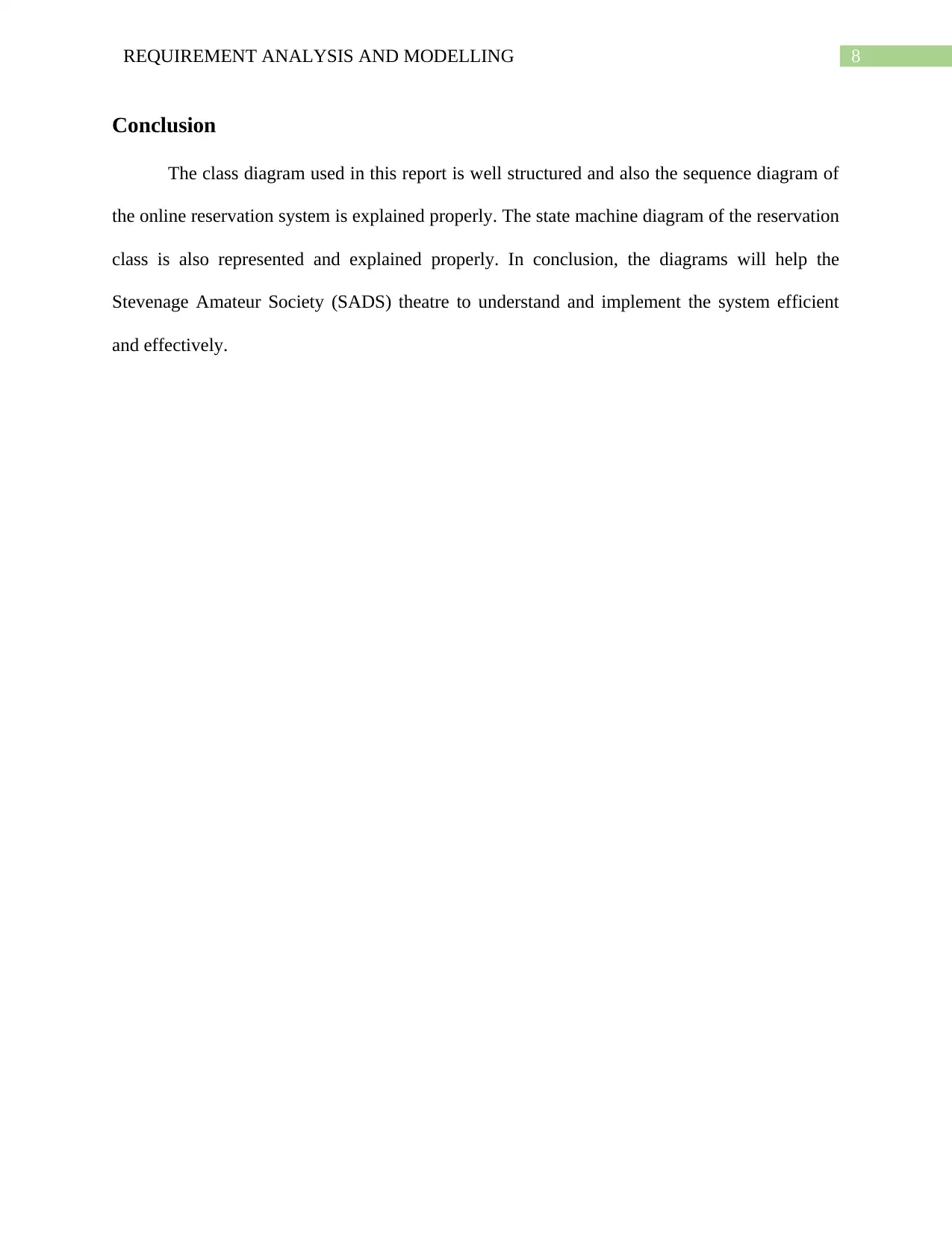
8REQUIREMENT ANALYSIS AND MODELLING
Conclusion
The class diagram used in this report is well structured and also the sequence diagram of
the online reservation system is explained properly. The state machine diagram of the reservation
class is also represented and explained properly. In conclusion, the diagrams will help the
Stevenage Amateur Society (SADS) theatre to understand and implement the system efficient
and effectively.
Conclusion
The class diagram used in this report is well structured and also the sequence diagram of
the online reservation system is explained properly. The state machine diagram of the reservation
class is also represented and explained properly. In conclusion, the diagrams will help the
Stevenage Amateur Society (SADS) theatre to understand and implement the system efficient
and effectively.
⊘ This is a preview!⊘
Do you want full access?
Subscribe today to unlock all pages.

Trusted by 1+ million students worldwide
1 out of 9
Related Documents
Your All-in-One AI-Powered Toolkit for Academic Success.
+13062052269
info@desklib.com
Available 24*7 on WhatsApp / Email
![[object Object]](/_next/static/media/star-bottom.7253800d.svg)
Unlock your academic potential
Copyright © 2020–2025 A2Z Services. All Rights Reserved. Developed and managed by ZUCOL.





